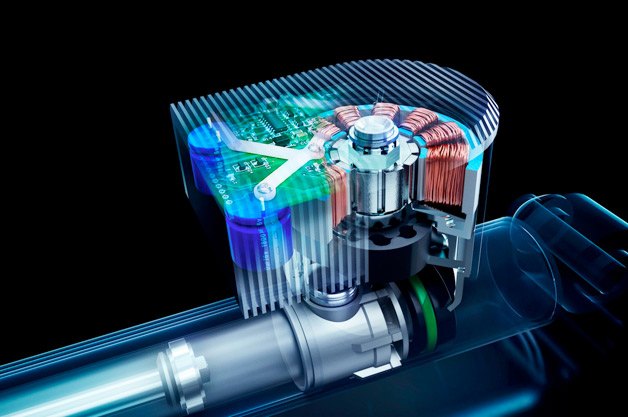ZF and Levant Power Develop Regenerative Active Suspension
ZF Friedrichshafen AG and Levant Power Corp., a Woburn, Massachusetts technology company spun off from MIT, have announced what they call the first fully active suspension system that includes a regenerative function that recovers energy from the motion of the suspension. The system is branded GenShock. Active suspensions are not new, General Motors experimented with an actively suspended ZR-1 Corvette when the automaker owned Lotus, which had worked with active suspensions before the technology was banned in Formula One. Going back even farther, there were the hydropneumatic Citroens and the last true Packards’ “torsion level” suspension. With road cars the goal in using such a system would be to combine good ride with good handling, soft sometimes and stiff sometimes, depending on the driving circumstances. Early tries at developing what chassis engineers call a “high bandwidth active suspension”, capable of dealing with those varying circumstances, have run into cost, complexity and power consumption issues. The GenShock system is claimed to be affordable, simple to integrate in existing suspension designs, and not only have modest power consumption but also be able to recover energy from the suspension.
The heart of the system is what Levant Power calls the Activalve TM, a device that combines electric and hydraulic motors (the companies are calling that an “electrohydraulic gear pump”) and can be adapting to standard mono, twin, and tri-tube damper configurations. Hydraulic fluid in the shock absorber is routed from the damper body through the valve, where the electric motor can be used to control the flow of fluid through the gear pump, or alternatively, the pump can be used to drive the electric motor as a generator, recovering electricity. The poorer the road quality, the more bumps there are, the more energy is recovered. Electronic controls adapt the damping characteristics to the driving situation, reducing body pitch and roll during cornering and braking. While the system adds a little bit of weight, compared to a passive suspension, it also eliminates the need to carry a jack, since the system is capable of raising or lowering each wheel independently.
Note that this is not a perpetual motion machine, like putting a wind generator on a car. It creates no new load on the powertrain, it merely recovers energy that would normally be turned into heat. ZF and Levant Power haven’t released any figures on just how much energy is recovered and whether that exceeds the power required to run the system. Like Innowatech‘s piezoelectric roadways, BMW’s Turbosteamer concept, or Purdue professor Xianfan Xu’s work recovering electricity from engine exhaust using large scale Peltier devices, the GenShock is harvesting energy that would otherwise go to waste.
More by TTAC Staff
Latest Car Reviews
Read moreLatest Product Reviews
Read moreRecent Comments
- Theflyersfan I wonder how many people recalled these after watching EuroCrash. There's someone one street over that has a similar yellow one of these, and you can tell he loves that car. It was just a tough sell - too expensive, way too heavy, zero passenger space, limited cargo bed, but for a chunk of the population, looked awesome. This was always meant to be a one and done car. Hopefully some are still running 20 years from now so we have a "remember when?" moment with them.
- Lorenzo A friend bought one of these new. Six months later he traded it in for a Chrysler PT Cruiser. He already had a 1998 Corvette, so I thought he just wanted more passenger space. It turned out someone broke into the SSR and stole $1500 of tools, without even breaking the lock. He figured nobody breaks into a PT Cruiser, but he had a custom trunk lock installed.
- Jeff Not bad just oil changes and tire rotations. Most of the recalls on my Maverick have been fixed with programming. Did have to buy 1 new tire for my Maverick got a nail in the sidewall.
- Carson D Some of my friends used to drive Tacomas. They bought them new about fifteen years ago, and they kept them for at least a decade. While it is true that they replaced their Tacomas with full-sized pickups that cost a fair amount of money, I don't think they'd have been Tacoma buyers in 2008 if a well-equipped 4x4 Tacoma cost the equivalent of $65K today. Call it a theory.
- Eliyahu A fine sedan made even nicer with the turbo. Honda could take a lesson in seat comfort.


































Comments
Join the conversation
I read all the negativity, and I remember my friends who would not buy a car with an automatic transmission because "it would break". Also, a friend that would not buy a car with electronic ignition because "it would break". You can be sure that if this active suspension system is put into mass production, it will be OK. If not the first iteration, by the time it works down to mass market vehicles, it will be OK. The same with electric cars. The first generation cars are not practical. The early adopters pay the price for buying early. People who wait, get the perfected product. But, without the early adopters, there would be no perfected product. Just because you would not buy it, does not mean that it should not be produced.
Now I'm no electrical engineer, but couldn't you make the bumps in the road produce electricity with just some sort of piezo electrical material between the spring and the perch on all 4 corners? Sure it wouldn't produce as much power as something like this, but it would cause no problems when/if it failed and could be implemented for a few bucks on any car.